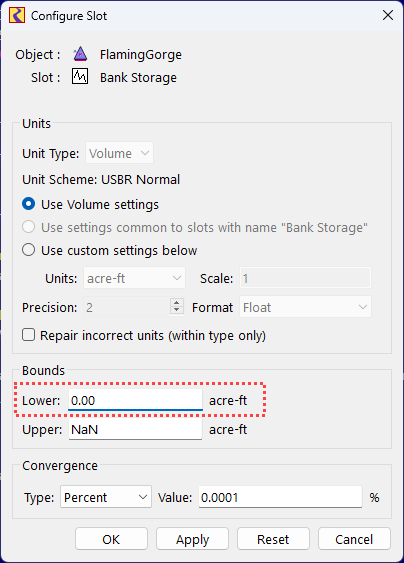Bank Storage
The Bank Storage methods are used to calculate the volume of water stored in the Reservoir banks. These methods also calculate the change in the volume of water stored in the Reservoir banks from one timestep to the next.
This method should be chosen to not calculate the amount of Bank Storage in the Reservoir. This is the default method for the Bank Storage category. Bank Storage and the Change in Bank Storage are set to zero but are not displayed. No calculations are performed in this method.
There are no slots specific to this method.
The Input Bank Storage method allows for direct input values of the Bank Storage slot or to set these values using a rule. Change in Bank Storage is calculated internally in RiverWare for use in the mass balance equations.
Slots Specific to This Method
Bank Storage
Type: Series Slot
Units: Volume
Description: Volume of water stored in the reservoir banks
Information:
I/O: Input or set by a rule
Links: Usually not linked, but could be linked to Data Object.
Change in Bank Storage
Type: Series Slot
Units: Volume
Description: change in volume of water stored in the reservoir banks
Information:
I/O: Output only
Links: Not linkable
The CRSS Bank Storage method replicates the U.S. Bureau of Reclamation’s CRSS bank storage calculation. The Bank Storage and the Change in Bank Storage are calculated using the Reservoir Storage and the Bank Storage Coefficients.
Slots Specific to This Method
Bank Storage
Type: Series Slot
Units: Volume
Description: Volume of water stored in the reservoir banks
Information: The lowest possible Bank Storage can be specified in the Slot Configuration on the Lower Bound. This value will be used in the calculation, shown below, if valid.
I/O: Output only
Links: Not linkable
Bank Storage Coefficient
Type: Table Slot
Units: No Units
Description: Gain or loss of storage vs change in bank storage
Information: The first coefficient (column zero) is for increasing storage and the second coefficient is for decreasing storage.
I/O: Required input
Links: Not linkable
Change in Bank Storage
Type: Series Slot
Units: Volume
Description: Change in volume of water stored in the reservoir banks
Information:
I/O: Output only
Links: Not linkable
Method Details
The change in Bank Storage is computed depending on the current Storage of the Reservoir. A temporary variable BankStorageTempChange is used in the initial calculations it may be adjusted later. If the Reservoir’s current Storage is greater than the previous Storage, the Storage is increasing and hence the Bank Storage should also increase. BankStorageTempChange is calculated using the following equation:

If the Reservoir’s current Storage is less than the previous Storage, the Storage is decreasing and hence the Bank Storage should also decrease. Bank Storage is calculated using the following equation:

In this case, Storage - Storage(-1) is negative so the BankStorageTempChange will also be negative.
Next compute the Bank Storage but make sure it does not go below the lower bound. The lower bound is taken from the Bank Storage slot configuration as shown in the screenshot, where it is set to 0.0 acre-feet:

The Bank Storage is then computed as follows:
If the Bank Storage Lower Bound is valid (not NaN),

Else the lower bound has not been specified (it is NaN),

Because of the possible modification due to the lower bound, the Change in Bank Storage is then calculated using the following equation:

where:
– Bank Storage = the volume of water stored in the banks of the Reservoir at the current timestep
– Bank Storage(-1) = the volume of the water stored in the banks of the Reservoir at the previous timestep.
– Storage = the volume of water in the Reservoir at the current timestep
– Storage(-1) = the volume of water in the Reservoir at the previous timestep
The Average Stage Change method calculates the Bank Storage and Change in Bank Storage based on the flow from storage. The flow from storage is a function of the average stage change over a user defined number of timesteps.
Slots Specific to This Method
Ave Stage Change Coeffs
Type: Table Slot
Units: Area per Time and Flow
Description: Coefficient describing flow for a given change in pool elevation and a constant representing flow from bank storage
Information:
I/O: Required input
Links: Not linkable
Bank Storage
Type: Series Slot
Units: Volume
Description: Volume of water stored in the reservoir banks
Information:
I/O: Output only
Links: Not linkable
Change in Bank Storage
Type: Series Slot
Units: Volume
Description: Change in volume of water stored in the reservoir banks
Information:
I/O: Output only
Links: Not linkable
Timesteps to Average
Type: Table Slot
Units: No Units
Description: Number of timesteps used to calculate average pool elevation.
Information:
I/O: Required input
Links: Not linkable
Method Details
The average stage change is calculated using the following equation:

The change in flow to bank storage is calculated using the following equation:

The flow is converted to a volume by multiplying the value by the current timestep. The Change in Bank Storage is calculated using the following equation:

Revised: 06/06/2025